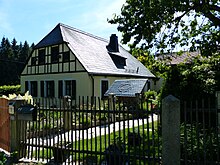Peat bog hell
|
Peat bog hell
City of Weißenstadt
Coordinates: 50 ° 5 ′ 48 ″ N , 11 ° 49 ′ 5 ″ E
|
|
|---|---|
| Postal code : | 95163 |
| Area code : | 09253 |
Torfmoorhölle is a district of the city of Weißenstadt ( district of Wunsiedel in the Fichtelgebirge , Upper Franconia ), as well as an extensive forest and moor area. The hamlet is located about five kilometers west of the city on the state road 2180 to Gefrees am Höllpass , to the south is the 124-hectare forest area with a former raised bog that has been largely drained.
Settlement on a historic street
As early as the Middle Ages, an army and trade route that linked the Franconian with the Bohemian region led across the Höllpass in a west-east direction . It did not run on the route of the current state road, but a little north of it on the slope. The geleitrecht had in 1500 the bailiff to White City . In 805, Charlemagne is said to have advanced with a war army from the main area over the Höllpass into the Eger area .
Name peat bog hell
In the land book of the six offices there is a reference to the "theretn loe" and the "Steig durch die Hell". First of all, this is an indication of tar smelling for the production of lubricants and sealing material from pitch (resin). Even then, the inhospitable area was an extensive moor and swamp area, which, like in other areas, was called "Hell" (hell) in dialect . The moorland and the peat extraction as well as the way through the "hell" provided for the today's name.
Peat extraction
The moorland with an area of 18 hectares was used for peat extraction for burning purposes. In 1792, mountain master Alexander von Humboldt described the peat bog as “Therichte Lohe ohnfern Weißenstadt” and recommended that the excellent root peat be extracted. In 1804 a peat master's house was built with sleeping places for peat workers who lived remotely, in 1852 the forest administration built dry houses and a steam engine was used. Until 1875, the peat bricks were bought by Bayreuth industrial companies and hammer mills in the area. 1945–1947 40 people were engaged in manual peat cutting.
Drinking water production
The city of Hof extracts part of its drinking water from the peat bog hell . Every year, up to two billion liters of water are taken through deep wells and in other collectors, pumped into a treatment plant and conveyed to Hof in a 45 km long pipeline with a natural gradient.
Natura 2000 program
As part of the Natura 2000 nature conservation program, measures were taken in 2006 after a professional inventory through a management plan to secure the raised bog complex and preserve it as a habitat for rare plants and animals. To those found in the Torfmoorhölle animal and plant species are Spirke , pine , downy birch , bilberry , cranberry , bog meadow Wachtelweizen , mosses , sundews ; Black stork , lynx , adder .
literature
- Dietmar Herrmann, Helmut Süssmann: Fichtel Mountains, Bavarian Vogtland, Steinwald, Bayreuther Land. Lexicon . Ackermannverlag, Hof (Saale) 2000, ISBN 3-929364-18-2 , p. 678 .
- Georg Kraus: Weißenstadt Homeland Book (1971)
- Wilhelm Müller: Old Passages in the Fichtel Mountains (1961)
- Friedrich Wilhelm Singer : The land book of the six offices of 1499 (1987)
Web links
- The peat bog hell in the Fichtelgebirge - entry on the website of the Fichtelgebirgsverein
- Entry on the homepage of the city of Weißenstadt



